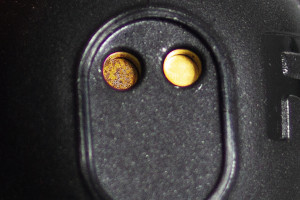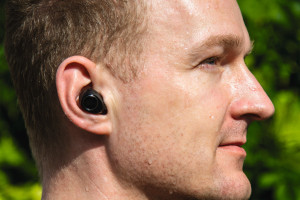Although most mobile devices are designed for long life cycles, these are often not achieved due to the necessary external connection. Charging contacts and connectors for short charging times or fast data transfer corrode and render the otherwise intact device unusable in an instant - an award-winning rhodium-ruthenium electrolyte offers a promising solution here.
 Rhoduna Alloy was originally developed for the decorative sector and has established itself over the years . Complaints from end customers due to non-functioning devices often lead to unforeseen costs on the manufacturer's side as well as damage to their image, which in the medium term result in an increased and therefore less attractive product price.
Rhoduna Alloy was originally developed for the decorative sector and has established itself over the years . Complaints from end customers due to non-functioning devices often lead to unforeseen costs on the manufacturer's side as well as damage to their image, which in the medium term result in an increased and therefore less attractive product price.
With Rhoduna Alloy, Umicore Electroplating from Schwäbisch Gmünd has created a rhodium-ruthenium electrolyte that addresses precisely this issue. The alloy, which can be applied by means of metal-saving electroplating processes using proven continuous mass production systems, gives contacts unprecedented corrosion resistance - without affecting features such as fast-charging capability.
Gold-plated contacts no longer meet growing expectations
The initially rapid development of cell phones, tablets, wireless headphones and smart fitness bracelets is increasingly slowing down. In the meantime, performance, design and handling have often become interchangeable across brands. As a result, even marginal price differences and sustainability are coming into focus. For consumers, the term sustainability does not necessarily go hand in hand with the environmental considerations often associated with it - rather, it is the expectation of a durable product that can be used at any time without hesitation.
This cannot be achieved with the current standard of gold-plated charging contacts and connectors. Wearables in particular are naturally not used in an environment protected from the outside world and are therefore exposed to galvanic corrosion conditions.
During leisure activities in particular, the devices often inevitably come into contact with chloride-containing liquids such as skin sweat, swimming pool or sea water or even drinks. Of course, most devices are at least splash-proof and initially give the impression that they have not suffered any damage. However, the danger is not in the immediate functionality, but in the medium term on the exposed contacts: in conjunction with chloride-containing solutions, gold-plated contacts inevitably corrode at high speed during the charging process.
Corrosion test proves suitability of the alloy
 Contacts of a fitness wristband after charging. The left contact, previously contaminated with welding solution, shows clear corrosion of the gold layer compared to the right, uncontaminated contact In an electrochemical corrosion test, an approx. one percent saline solution (250 ml) is applied to a voltage of 5 V at 40 °C. This is used for a complete charging cycle in an electrochemical corrosion test. This simulates a complete charging cycle in 30 seconds with contacts contaminated with sweat. After just 2.5 minutes, the 0.75 μm gold layer normally used for contacts has completely dissolved and the nickel substrate is already heavily corroded. In contrast, no corrosion can be seen in the Rhoduna Alloy alloy under polarized light at 20x magnification. "The chemically almost inert final layer has very low porosity and the overall system therefore has excellent corrosion resistance," says Martin Stegmaier (Head of Decorative Applications), confirming the unprecedented coating characteristics.
Contacts of a fitness wristband after charging. The left contact, previously contaminated with welding solution, shows clear corrosion of the gold layer compared to the right, uncontaminated contact In an electrochemical corrosion test, an approx. one percent saline solution (250 ml) is applied to a voltage of 5 V at 40 °C. This is used for a complete charging cycle in an electrochemical corrosion test. This simulates a complete charging cycle in 30 seconds with contacts contaminated with sweat. After just 2.5 minutes, the 0.75 μm gold layer normally used for contacts has completely dissolved and the nickel substrate is already heavily corroded. In contrast, no corrosion can be seen in the Rhoduna Alloy alloy under polarized light at 20x magnification. "The chemically almost inert final layer has very low porosity and the overall system therefore has excellent corrosion resistance," says Martin Stegmaier (Head of Decorative Applications), confirming the unprecedented coating characteristics.
Rhoduna Alloy honored with the Surface Technology Award 2020
Umicore Electroplating earned a top ranking with Rhoduna Alloy at the Stuttgart Surface Technology Prize, which is awarded every two years by the world-renowned Fraunhofer Institute for Manufacturing Engineering and Automation IPA. Its head of department for electroplating technology, Dr. Martin Metzner, explains the 3rd place with a simple fact: "Umicore ... has succeeded ... in countering the complex and often adverse influences to which the contacts of mobile devices are exposed". Uwe Manz (Head of Research & Development) is particularly pleased with the award for one reason: "Of course, our commercial success shows that we are developing the right products for the various markets. But the award also confirms that we are still at the forefront in terms of innovation, sustainability, enabler qualities and industrial feasibility - the criteria for the award."
Sustainability brings economic efficiency
The use of the electrolyte offers users a longer service life and therefore sustainability for their mobile device. The manufacturer also benefits in two ways: on the one hand, the additional product reliability contributes directly to the manufacturer's image. Secondly, Rhoduna Alloy makes the overall costing more economical - despite the four times higher investment for the alloy compared to the gold layer.
 The electrochemical ASET (Artificial Sweat Electrolysis Test) demonstrates the corrosion resistance of Rhoduna Alloy compared to the previous standard gold. After just over 2 minutes, the gold layer is dissolved and the nickel layer is corroded. The rhodium/ruthenium alloy, on the other hand, remains stable.
The electrochemical ASET (Artificial Sweat Electrolysis Test) demonstrates the corrosion resistance of Rhoduna Alloy compared to the previous standard gold. After just over 2 minutes, the gold layer is dissolved and the nickel layer is corroded. The rhodium/ruthenium alloy, on the other hand, remains stable.
 Wearables such as wireless headphones can no longer be charged once the corrosion on the contacts has progressed and are therefore unusable. While it is difficult to measure the image gain and the resulting supposedly higher sales volume will only have an impact in the medium term, the savings in terms of complaints due to corroded contacts can be clearly and immediately quantified: costs for correspondence, logistics and the repair or replacement of defective devices are eliminated without replacement.
Wearables such as wireless headphones can no longer be charged once the corrosion on the contacts has progressed and are therefore unusable. While it is difficult to measure the image gain and the resulting supposedly higher sales volume will only have an impact in the medium term, the savings in terms of complaints due to corroded contacts can be clearly and immediately quantified: costs for correspondence, logistics and the repair or replacement of defective devices are eliminated without replacement.
Test production during changeover
Before any possible introduction or changeover to the new electrolyte, an unusually detailed survey of the previous process environment is carried out, which, according to the company, ensures that production can be set up smoothly and, in the worst case, that there are no production downtimes. "For us, test production in the customer's environment is part of the changeover," says Markus Legeler (Head of International Sales), describing the onboarding process for customers


